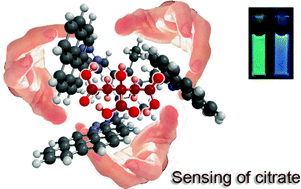Tris(triazole) tripodal receptors as selective probes for citrate anion recognition and multichannel transition and heavy metal cation sensing†
Abstract
The three-armed pyrenyl-triazole receptor 1 behaves as a highly selective fluorescent molecular sensor for citrate anions over similar carboxylates such as malate or tartrate. In addition, this receptor senses Cu2+ cations through absorption and emission channels even in the presence of Hg2+ metal cations. The related three-armed ferrocenyl-triazole receptor 2 behaves as a highly selective dual (redox and chromogenic) chemosensor molecule for Pb2+ metal cations.


 Please wait while we load your content...
Please wait while we load your content...